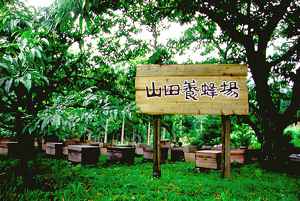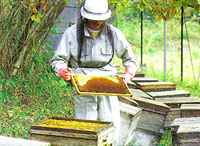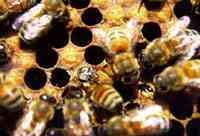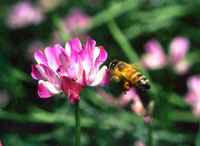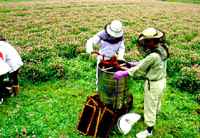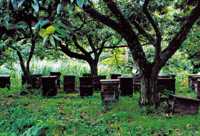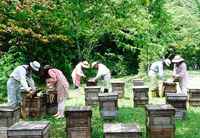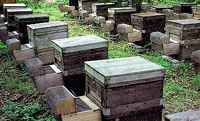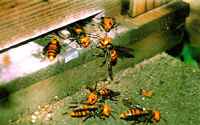1.
Early Spring
When the snow melts and the air warms, the
queen bee starts to lay eggs, the number of honeybees increases,
and the bees become active, gathering pollen from the early-blooming
flowers of the Japanese Apricot and Eurya Japonica. By the end
of March the hive becomes full. The first honey can be extracted
around the time that the cherry blossoms have fallen and the clover
begins to flower. Before this honey extraction, the hive has been
emptied of the honey remaining on the frames from the previous
year so that only freshly produced honey is extracted. |
|
|
2. Spring
When the clover begins to flower it is just
about time to extract the honey. The honeybees actively gather
nectar and store the honey on the frames. We wait until the
honey matures, then extract it as we give thanks to the honeybees
who worked so hard to gather the honey.
|
|
|
3. Summer
When the clover flowers are over, we move
the bees to the mountains. In this season many kinds of trees
flower in the mountains and we can extract plenty of honey.
The number of honeybees also continues to grow, and it is now
that bees leave the hive, so you must be careful about swarms.
The time of year from spring to summer is the busiest for beekeepers,
but it is also the most rewarding.
|
|
|
4. Autumn
Around the middle of August, measures must
be taken against hornets, the bees' natural enemy. We must particularly
watch out after a typhoon, when hornets are most likely to appear.
The number of honeybees has begun to decline, so one by one
we remove frames from the hive. We also need to make sure that
enough honey remains for the bees to survive through the winter.
|
|
|
5. Winter
It is important to protect the honeybees
from the cold for the duration of the winter, so we keep them
in a location that gets plenty of sunshine but is protected
from the wind. When it becomes cold the bees huddle together
in a "winter cluster" that stays at about 25°C internally throughout
the winter. The bees remain motionless inside the hive, not
wasting any energy. They feed on stores of honey and wait for
spring to arrive. This is the best season for beekeepers to
repair and clean the hives that will be used in the coming year,
and like the bees, wait for spring.
|
|
|

